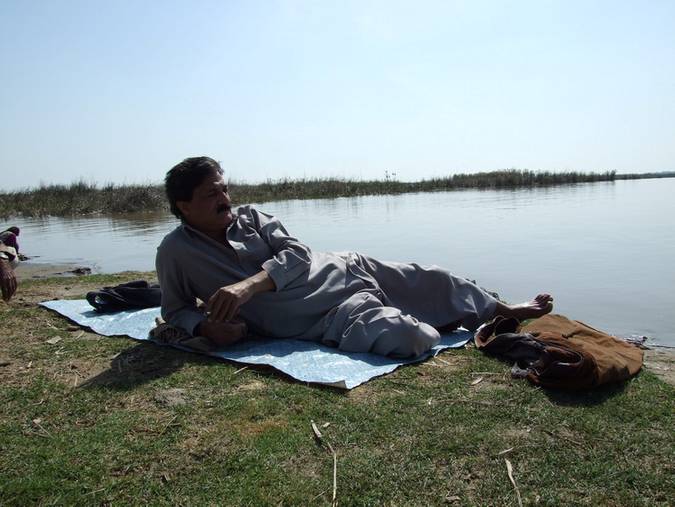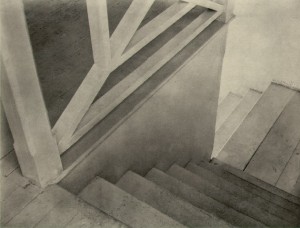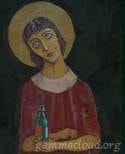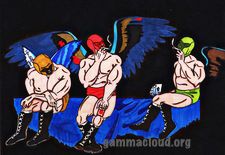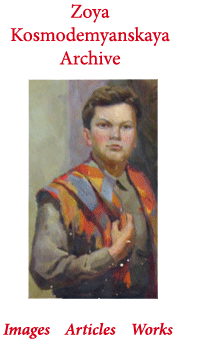Ibne Hasan
1954 – 2012
 Syed Ibne Hasan was a true inspiration in the continuing struggle for a better world. Hasan was an Associate Professor at Government Postgraduate Islamia College in Gujranwala, Pakistan as well as an integral member of the Marxists Internet Archive Collective, building and directing a number of non-English Archives as well many English-language sections.
Syed Ibne Hasan was a true inspiration in the continuing struggle for a better world. Hasan was an Associate Professor at Government Postgraduate Islamia College in Gujranwala, Pakistan as well as an integral member of the Marxists Internet Archive Collective, building and directing a number of non-English Archives as well many English-language sections.
With the assistance of Imtiaz Hussain, Ibne Hasan published the first-ever Urdu translation of Marx’s Capital in 2006. Unlike any other previous translation of Marx in any language, this translation was first published free to the public domain in electronic form on the Internet. The same year, I was fortunate to work closely with Hasan in creating the Bhagat Singh Internet Archive for MIA. When I informed him that an online source was unwilling to provide me with permission to include Singh’s seminal work “Why I am an Atheist” in our fledgling archive, Hasan arranged for a new, original translation of the work from the original Gurmukhi text to Urdu, the latter of which was then translated to English by Hasan himself. With his indispensable help, we ultimately created a new edition of this important work which we subsequently shared on the Internet, copyright-free for all to reproduce and share. Hasan also distributed books, CDs, and DVDs to students and workers throughout South Asia. In 2008, the administrators of MIA honored Hasan with a special award.
Hasan was an expert on the music of South Asia. We shared an appreciation for the Golden Age of Bollywood and provided me with hundreds of songs that he painstakingly transferred from his collection of rare 78 RPM records. He would often translate names or lyrics from Hindi movie songs at my request, sharing his perspective and interpretations on the words and melodies.
Farewell, dear friend. Though the world would benefit from many, many men like you, there will never be another Syed Ibne Hasan. Μάιος η μνήμη του είναι αιώνιος.
— Mike Bessler, 27 January 2012
Below are some articles and comments by Ibne Hasan that were posted on our old website. Despite the fact that he wrote perfect English, he always asked me to proofread his work for errors since the language was not his mother tongue. In the passages below, I have made only a handful of very minor changes.
An open letter from Pakistan 18 October 2005
Written in the aftermath of the earthquake that devastated parts of northern Pakistan in late 2005, I was one of a handful of original recipients of this “open letter” from Hasan. He later permitted me to share it on the Internet through my blog.
I went to ‘Baagh’, a city 60 miles from Muzaffar Abad to visit a colleague who lost 130 members of his family. The city is reduced to rubble. A pungent smell of human corpses is felt all around. The people say that at least 50 thousand people have died in one city alone. The total number must be well above 200, 000. Thousands of trucks with relief goods are arriving here from all over Pakistan. In fact in every street and on every road common people are collecting these items and then bringing them to the quake hit areas by themselves. No one believes the government. No common man is contributing to the “President’s Relief Fund”. In spite of this huge effort on the part of the public, relief has not reached far-flung areas. Everywhere there are looters who stop the trucks and take away everything. I observed that all those who have survived are haunted by death; many have died; many are dying every moment. They cannot weep at any death that occurs for tears have dried in their eyes. Many have lost their senses. I met an educated man who has lost many relatives. He would go to the place where dead bodies are kept and lie down among decaying corpses. His friends had to drag him back every time. He recites this poem again and again:
Let me move to a place where I have no friend, no, nor any companion
No one who is kind; no one who says sympatric words to me.
Let me make a house which has no walls,
No neighbour, no one who speaks my language.
And if I fall ill, there is no one to comfort me in distress,
And if I die, there is no one to shed tears over my dead body!
At first I could not understand this cynical attitude and extreme depression. Soon I realised that all feel humiliated. A bureaucratic system of distributing relief goods has been evolved to reduce the people to a kind of beggary. One has to be either a looter or a beggar in order to get food or clothing. Nobody from the government or army reached them on the first two days. They were busy in “Margala Towers”, one of the most expensive residential areas in the capital. It is the only building that collapsed in Islamabad because substandard material had been used in the construction of it. Thanks to common people who are trying to reach everyone.
Many will squeeze money and prosperity out of it. The bus owners charge as much fares as they will. The truck fares have risen many times. When shopkeepers observe that you are purchasing clothes or blankets for the quake victims, they rob you. And our generals and bureaucrats and ministers etc, they will be earning millions. Only a tiny part of the aid that is being received from the international community will go to the people. Our Lions will receive the Lion’s share. Only yesterday a brigadier was caught red-handed selling 4 relief trucks. The government is quick to deny it. What a pity! What shame! These traders of religion; the sellers of human shrouds! Deaths of thousands of human beings will bring them billions of money.
This is the tragedy of Pakistan, or perhaps of all under-developed countries. This is, as Marx has commented somewhere, like France of Balzac’s novels, or perhaps worse than that. We are carrying the stinking carcass of feudal ages with all its decadence, moral decay, self-indulgence, corruption, depravity on our shoulders; added to it is all the greed, an intense, inordinate longing for wealth; a covetous desire for money that always comes with the bourgeois society.
This is Pakistan with its culture and civilization which is the fittest place for dictators to rule.
— I.H.
Re: Mughal-E-Azam 23 July 2006
When I became interested in Indian Cinema in 2006, I asked Hasan if he could help me to understand some of the lyrics of songs from Mughal-E-Azam, including the qawwali song “Teri Mehfil Mein Qismat,” which he absolutely hated. When I finally posted my own review of the film, he was happy to read it and share his own thoughts.
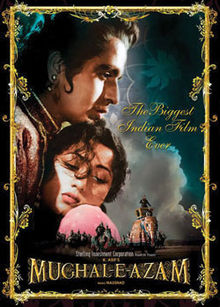 Mike deserves our appreciation for understanding the film Mughal-E-Azam quite well. Though he does not know Urdu, the tune and rhythm of songs has not evaded his music sense. The two songs he has mentioned are quite ordinary and there is poetry stereotyped. The music director of this film, Naushad Ali, is much extolled by the press but if we compare him with great music directors of those times, he stands nowhere. Only two music directors of Indian film industry. R. C. Boral and Anil Biswas understood that a musical composition should be an organic whole. The poetry and the music pieces should be in a sequence forming a continuous whole. Listen to all the songs R. C. Boral composed for K. L. Sehgal to understand the meaning of my statement. Moreover, music is not reciting poetry with the accompaniment of music; it is conveying emotion contained in the words through music. These two music directors had another merit for they put flute notes or violin orchestra as a background to the main composition in order to enhance the effect. Listen to songs of “Mehman” and two famous duets of Taran for this. Also listen to songs from the films Jalti Nishani, Fareb, Naaz, Lajwab, and many more.
Mike deserves our appreciation for understanding the film Mughal-E-Azam quite well. Though he does not know Urdu, the tune and rhythm of songs has not evaded his music sense. The two songs he has mentioned are quite ordinary and there is poetry stereotyped. The music director of this film, Naushad Ali, is much extolled by the press but if we compare him with great music directors of those times, he stands nowhere. Only two music directors of Indian film industry. R. C. Boral and Anil Biswas understood that a musical composition should be an organic whole. The poetry and the music pieces should be in a sequence forming a continuous whole. Listen to all the songs R. C. Boral composed for K. L. Sehgal to understand the meaning of my statement. Moreover, music is not reciting poetry with the accompaniment of music; it is conveying emotion contained in the words through music. These two music directors had another merit for they put flute notes or violin orchestra as a background to the main composition in order to enhance the effect. Listen to songs of “Mehman” and two famous duets of Taran for this. Also listen to songs from the films Jalti Nishani, Fareb, Naaz, Lajwab, and many more.
Some people who have not listened good choruses praise Naushad for his choruses. His choruses are monotonous as there are not multifarious ‘forces’ within a composition which though different, combine to develop the theme of the songs. I would refer to choruses of “Jawar Bhata,” “Lajwab” and “Dhunwan” as good examples.
No doubt the story is set in feudal India, with its ugly culture and customs. The story may be a protest against the restrictions imposed upon the institution of love in that era, but what love is in itself, we do not get any clue. The man behind this film K. Asif had a method of his own: He would hire three or four heroes or heroines in a film, build grand expensive sets, heavy costume to put the viewer in a state of awe. It is like preparing halwa (an Indian sweet dish) and then adding more sugar on it. This left the whole dish vapid and tasteless and smacked of a cook who not knowing the method of cooking adds more and more spices in his food. Grand-scale advertising makes a film popular but it cannot be a piece of art in this way.
— Ibne Hasan
Re: Mother India 19 September 2006
After watching Mehboob Khan’s Mother India, I posted a review of the movie and sent it to Hasan for comment. His reply included a detailed discussion of historical themes in Indian cinema and literature along with his unrestrained opinions on the topics at hand. Although he was always diligent at leveling criticism as warranted, he shared some appreciation for the themes and overall message of the film.
Trends have changed and now it has become a fashion in the Indian film industry to picturise every cock and bull story. Only ten or fifteen years ago there were only three or four dominant themes.
(1) Two brothers, or son and mother, or father and son get separated in the beginning of the film and are united in the end.
(2) A rich boy falls in love with a poor girl or a rich girl falls in love with a pauper. No one ever knows ‘WHY?’
(3) Cruelties of a big feudal lord or a usurer or a powerful mafia boss and the resistance of a poor person who can fight twenty or thirty of their hirelings at a time.
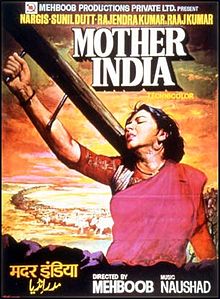 Someone has counted films on these themes and without exaggeration the figures run in hundreds. People go to the movie theatre to watch the semi-naked dances, listen to songs or watch such bizarre scenes as the heroine dancing in rain.
Someone has counted films on these themes and without exaggeration the figures run in hundreds. People go to the movie theatre to watch the semi-naked dances, listen to songs or watch such bizarre scenes as the heroine dancing in rain.
Apparently, Mother India has the oft-repeated story of a usurer, and people suffering because of his heartless behaviour. Many scenes seem to be overdone and have a shocking effect. However there is something new added to the story: it is about the heroic struggle of a woman. After a long, hard struggle she succeeds in life.
Mother India was originally made with the name Aurat (woman) in 1940. The poster of the film had the caption: AN EPOCH MAKING PICTURE OF INDIAN VILLAGE LIFE.
It shows two women doing household chores. But this is not all. The story is set in feudal India where women were considered household slaves. Their task was only to raise children and serve their husbands. If the husband of a woman died, she was reduced to utmost poverty. Most of the people were landless farmers who earned their living by tilling the small piece of land given to them by the landowner of the village on rent. Only in later stages there arose small landholdings of one or two acres. The landowner took almost all the crop and only a little was left for the farmer. In these social conditions, the “usurer” provided small loans which they spent on marriages or religious ceremonies. I would refer to short stories of Prem Chand who has depicted the misery and sufferings of the village people like a true realist. As the village people were illiterate the usurer received high rates of interest and used all the thuggery and shrewdness to write whatever he liked in the account books.
Many rebelled against this practice and became robbers. With all these stereotyped elements of the story, the film Mother India tries to give a vision of future Indian woman. She would fight all adversity with courage and wisdom. This makes it different from the films of the same kind. This is the reason that both the films Aurat and Mother India were big hits.
The music of Aurat was composed by Anil Biswas; Naushad gave music for Mother India. Aurat has some beautiful choruses. One of these “Kahe kerta der baraati’ expresses the idyllic atmosphere of a village when the inhabitants forget their worries in singing songs and dancing. The songs of ‘Mother India’ are quite ordinary and lack artistic touch.
— Ibne Hasan
Re: Rang de Basanti 28 August 2006
As noted above, Hasan and I worked together in building an archive of Bhagat Singh’s works in 2006. When I shared my notes of Rang De Basante, a Bollywood film loosely based on the life and martyrdom of Bhagat Singh, Hasan replied with notes on Singh’s enduring legend.
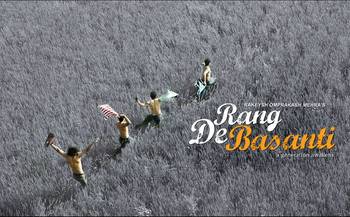 Manoj Kumar’s Shaheed was the true story of Bhagat Singh. The director did not romanticise the story and tried to be as close to facts as possible. It had some good songs. The story of Bhagat Singh’s life and his martyrdom is so powerful that mere re-telling it, without any embellishments, holds us in awe by the courage and valour of the freedom fighters.
Manoj Kumar’s Shaheed was the true story of Bhagat Singh. The director did not romanticise the story and tried to be as close to facts as possible. It had some good songs. The story of Bhagat Singh’s life and his martyrdom is so powerful that mere re-telling it, without any embellishments, holds us in awe by the courage and valour of the freedom fighters.
Before this film another film of the same name Shaheed was produced which starred Dilip Kumar. It was about the freedom struggle of the Indian people against the British Imperialism. The story writer might have been impressed by the heroic struggle of Bhagat Singh but it was not a film about him.
In recent past two films were produced on the same theme and both were big hits. This phenomenon is worth studying.
About eight films were based on the folk love tale of “Heer Ranjha” and all were liked by the common masses. Other examples of the same sort are films on Laila Majnoon, Mirza Sahibaan, Sheereen Ferhaad, etc. All are folk tales and in this period when people are modernised and under the great influence of Western Culture, it seems strange that they should appreciate these traditional love stories. Story is an essential element in a film and the people already know every bit of detail in these tales.
I think the explanation should be sought in the literature that is created by the masses. I mean the literature that is written by the people and they evolve it in fairs, in ‘chaopaals’ (places where they sit together). New colours are added to it by folk singers, by poets whose names we never know.
The story of Bhagat Singh’s martyrdom might have inspired some film producers; the real point is that huge bulk of literature emerged about it. A person whose father was one of Bhagat Singh’s comrades and who was hanged by the Britishers told me the following story:
In those days, there was a tonga-stand outside the Lahore Railway Station and the tonga drivers sat under a big tree in the afternoon. One of the tonga-drivers who was an illiterate person wrote a poem about Bhagat Singh. The poem was “ghorrian” a form of Punjabi poetry which is sung by women when the bridegroom is getting ready to move to the house of the bride. Bhagat Singh was hanged when he was a young man of only twenty-two. A big crowd gathered there and he recited the poem again. All were spellbound. All had tears in their eyes. The patrolling platoon at once took notice of this gathering. The head of the platoon, an Englishman ordered the tonga-driver to stop reciting the poem. He knew the poem was sowing seeds of mutiny in the minds of the people. Undaunted by his threats, the tonga-driver continued with his poem. The Englishman ordered the Indian soldiers to fire at him. They refused. He himself fired shots at the tonga-driver and killed him.
The poems written on Bhagat Singh run in hundreds. This is the literature that truly represents the ‘spirit’, the collective consciousness of the people. This is what they own and feel themselves to be one with. At a higher level, a Realist Writer is also a prophet of this Spirit. He does not stop at presenting what we call ‘a true picture of reality’, his vision transcends the existing present and he foresees the Future. This is the vision of humanised existence for all. He moves along the high road of culture and the past and present combine to give future a shape. In this vision future dreams are mediated by reality.
Re: Hum Aapke Hain Koun..! April 2010
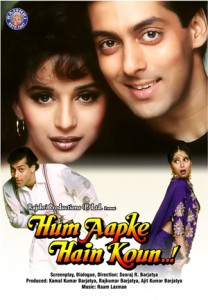 In 2010, I watched the Bollywood blockbuster film Hum Aapke Hain Koun..! and, having previously discussed Indian films and music with Hasan, I wrote to him and asked his opinions on the movie. While he had not seen it, he expressed a willingness to watch it and have a discussion. Hasan also shared about about his collection of rare music.
In 2010, I watched the Bollywood blockbuster film Hum Aapke Hain Koun..! and, having previously discussed Indian films and music with Hasan, I wrote to him and asked his opinions on the movie. While he had not seen it, he expressed a willingness to watch it and have a discussion. Hasan also shared about about his collection of rare music.
02 April 2010
I have not watched the film Hum Aapke Hain Koun..! (Who/What I Am For You). This film was released one or two years back and I have not watched it. I have been collecting Indian film and classical music and the number of songs has reached almost 13 thousand. The collection is mostly from 1932 to 1956.
* * *
Indeed, Hasan had sent me a huge cache of CDs the previous year and I reminded this of him, asking if I could make copies and share them with someone who had recently opened a new Indian and Pakistani grocery store near my home. Hasan’s generosity was resoundingly clear in his response.
03 April 2010
I have never refused copies of DVDs to anyone who has some interest in such stuff. You may give copies to any person. The collection has many rare songs which are not available on the internet. These were recorded from 78 RPMs.Yes, you may write your comments on the film. If possible send me an email.
* * *
Hasan later read my review of Hum Aapke Hain Koun..! and decided to seek out a copy for himself so we could compare notes. He also expressed some curiosity regarding my interest in Indian music, noting that I could neither speak nor understand Hindi or any of the other languages of the region. I had hoped he would expound on the matter of his comments regarding “pure music,” but I do not recall ever having that conversation in detail.
15 April 2010
…I read your comments. I will procure a copy of the film and watch it. Because of my “notoriously classical bent of mind” it is a hard job to watch modern Indian movies. I watch a film only for its music.
India did produce some good films in the past. Some critics say India produced only two good actors in the past: Motilal and Balraj Sahani. It is very difficult to procure the films in which Motilal acted but some of Balraj are easily available.
India produced good music during the years from 1940 to 1955; after that most of the stuff is rubbish. India also gave some great classical singer. Some of the names are: Omkarnath Thakur, Narayanrao Vayas, Vinayakrao Patwardhan. You can get some songs of these singers on the internet.
My question should be: when you do not understand the language, what is it in these films that interests you? You do not understand the language of the songs. So do you find the tune itself absorbing? I am myself a believer in “pure music.” I mean that music does not need the help of words to create the effect or the mood of the melody/tune. Indian classical music proves this point as words are absolutely of no value in it.
— Ibne Hasan
* * *
I can’t remember if Hasan ever actually procured a copy of Hum Aapke Hain Koun..! and if we had any further discussion about the movie, our correspondence about that subject has vanished into the ether of the Internet forever. Based on the opinions he shared about contemporary films and music, I would guess that he probably would not have appreciated the movie regardless of the fact that it was one of the most successful films in Bollywood history.
We had also talked in passing about discussing a 2005 biopic about Subhas Chandra Bose but we never got around to that as we both has many projects to tackle, both individually and together through our work for the Marxists Internet Archive.
“Curbing the Flood” in today’s Pakistan 01 November 2010
The following note was penned Hasan in the weeks following the 2010 Pakistan floods. Like his notes on the 2005 earthquake, he signed the piece with his initials due to concerns regarding the political content therein.
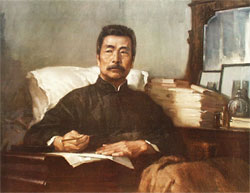
Lu Xun (Lu Hsun)
Lu Xun’s story “Curbing the Flood” may be read as a comment on the recent flood in Pakistan. Various characters appear and Lu Xun upholds to ridicule their attitudes and ways of thinking. The rulers, ministers, intellectuals, all are closed in their own limited thinking and prejudices. He also depicts what may be called “Culture of Poverty.”
The members of the upper and middle classes giving lessons of alms-giving, taking pity on the poor, sharing their grief performing the “holy act of Zakat.” (Zakat is an Islamic concept: Allah the Almighty has created the poor and has given you plenty so you must give a little portion of your wealth to the poor. The amount given will be multiplied by 70 when you go to paradise. It proves that God does not like poverty, though he has created the poor.) On the Pakistani TV channels we see honest and upright ministers, tender-hearted players, reputable actors, beautiful actresses, and conscientious traders giving the lesson of charity and generosity. They have also learnt many verses from the Holy Quran and also how to bring tears into their eyes. I call it “Culture of Poverty” because it gives them a feeling of superiority, a feeling that they are above the scum of society. Above all, it is an effort to maintain these humiliating conditions where majority of the people live below human level.
Lu Xun was under the influence of the May Fourth Movement when he wanted to bring a change in the Chinese society. Like Goethe, he used the old Forms but these were modified and given a new meaning by the contemporary truths. It is the re-evaluation of China’s mythology, in Old Tales Retold. The Chinese intellectuals, like the Pakistani ones, were alienated from political activity. Lu Xun praises Yu, the man who acts to bring a change society in “Curbing the Flood.” In this way he encourages his readers to challenge the status-quo.
— I.H., August 2010
Other Writings
Memories of Ibne Hasan 19 May 2013
A couple of weeks ago, I attended a large public awards ceremony honoring the achievements of some local kids and young adults. When the award recipients were announced, one of the names I heard was both distinct and familiar: the name was “Najma.” I did not personally know the young lady in question but her name reminded me of a special person and a story about him that I hadn’t thought of in quite some time.
 Najma Akhtar, also known simply as “Najma” is a British-born singer who has performed in a number of styles and genres, including traditional Indian and Pakistani songs and Bollywood-style music. That’s who I thought of first when I heard the name “Najma” uttered at the ceremony. My mind then quickly shifted to my late friend Ibne Hasan for reasons which I shall now explain.
Years ago, I wrote to my Hasan asking his opinion of the song “Parvanon” by Najma. I had just discovered the song on the 3 CD set Essential Guide to India (Union Square Music, 2006), which I’d purchased as part of my longstanding affinity for Bollywood music. As I’ve written elsewhere, Hasan was a true aficionado of many, many styles of music from India and Pakistan and he was always enthusiastic to share his insight and opinions with me. We’d corresponded at length about the subject of music over the course several years and he’d sent me a number of CDs and DVDs packed with thousands songs from his personal music collection, many of which he had painstakingly transferred from old, brittle vinyl records to mp3 using the best recording equipment he could find (including an old tube phonograph that apparently didn’t work well on rainy and humid days). Has was never critical of the fact that I couldn’t speak Hindi, Urdu or Persian, recognizing that I was motivated to learn and appreciate as much as possible about life and culture throughout the Indian subcontinent.
Najma Akhtar, also known simply as “Najma” is a British-born singer who has performed in a number of styles and genres, including traditional Indian and Pakistani songs and Bollywood-style music. That’s who I thought of first when I heard the name “Najma” uttered at the ceremony. My mind then quickly shifted to my late friend Ibne Hasan for reasons which I shall now explain.
Years ago, I wrote to my Hasan asking his opinion of the song “Parvanon” by Najma. I had just discovered the song on the 3 CD set Essential Guide to India (Union Square Music, 2006), which I’d purchased as part of my longstanding affinity for Bollywood music. As I’ve written elsewhere, Hasan was a true aficionado of many, many styles of music from India and Pakistan and he was always enthusiastic to share his insight and opinions with me. We’d corresponded at length about the subject of music over the course several years and he’d sent me a number of CDs and DVDs packed with thousands songs from his personal music collection, many of which he had painstakingly transferred from old, brittle vinyl records to mp3 using the best recording equipment he could find (including an old tube phonograph that apparently didn’t work well on rainy and humid days). Has was never critical of the fact that I couldn’t speak Hindi, Urdu or Persian, recognizing that I was motivated to learn and appreciate as much as possible about life and culture throughout the Indian subcontinent.
I was eager to learn his impression of the Najma track because I had already become familiar with her singing after procuring her 1987 debut album Qareeb at a second-hand record shop in Fort Wayne, Indiana. At some point after that, I’d discovered that Najma performed live with Robert Plant and Jimmy Page as part of their “UnLedded” special in 1995, providing backing vocals for “The Battle of Evermore.” In fact, Plant introduces Najma by her full name, Najma Akhtar, after the “Evermore” performance concludes.
After ripping “Parvanon” to mp3, I sent the song to Hasan via e-mail, keenly awaiting his thoughts on the track. I’m sure that at some level I’d hoped that he would praise the song as well as my developing penchant for high-quality Indian music. That’s what I’d hoped, anyway. Less than 24 hours, I heard back from Hasan but his response was not at all what I’d expected. Hasan criticized Najma’s timing relative to the meter of the lyrics, he didn’t like her voice and he summed things up by ultimately describing the piece of music as “unimpressive.”
I wasn’t disappointed, though. On the contrary, I felt honored that he’d taken time out of his day to listen to the track and respond in direct and specific terminology. That was Hasan, through and through: honest and unassuming, enthusiastic and candid as both a teacher and a friend. I still miss chatting with him and learning from him. To this day, I keep a small photo of him on my side of the bedroom and I reflect on him often, in hopes that there will someday be more good men like him to lead by instruction and example.
Ibne Hasan’s “Literature and Objective Truth” (excerpt) 13 June 2013
Below is a short excerpt from the late Syed Ibne Hasan’s unfinished manuscript “Literature and Objective Truth.” Hasan’s former students Sibghat and Nasira translated this version from Urdu and it is presented here with their kind permission. I have made a few minor grammatical corrections and redacted a few sentences that require additional clarity from the translators.
Literature and Objective Truth (Part 2)
by Ibne Hasan
Established theories about aesthetics:
Since the word “ART” is used in such broader sense of meanings and for a large number of things, it seems impossible to define and formulate on the philosophical basis of “what art is.” Is an integrated and scientific knowledge of aesthetics possible? Beauty is found in a large number of things, such as natural scenery, birds, animals, colors, human beings, et cetera. But if it is said that everything is art, this is merely a hollow theory, because it will have either no opposite or some contradiction. It will have no boundaries–no matter a thing has very vast boundaries; but it must have some limits. If a thing has no determinations (its being or nothingness makes no difference), then its existence and non-existence will be alike. If the beauty partaken of a piece of art is not differentiated/distinguished from the beauty of the rest of the things, then the piece of art will lose its individuality. In this case, War and Peace and “Raga Malkauns” have no attribute that may distinguish them from a news report or the noise of a fish market. Hence, all existing things have the very same validity…If someone says, “Look! This is a bird,” only a child or a stupid person can say this, because other people will want to know something more about that bird; some special feature, or what kind of bird it is. So then, it is necessary to distinguish the beauty of art and literature from the other kinds of beauty in the light of (with the reference of) their determinations.
… Dialectical philosophy is the superior form of the scientific approach/thought that analyzes a thing or a process within its necessity. It does not assess them in the reference of an artificial need. It also rejects its objective classification. Art and literature is an extensive human praxis and it has a large number of forms, which are differentiated by and through their means, or modes of expressions. Despite this difference, they possess some particular [common] features and/or qualities that exist in [all of] the different genres of art and literature. Is such [scientific] knowledge possible, which studies simultaneously the identities and the differences [in arts](or common and different features/qualities) and explain the conditions, which caused the…



